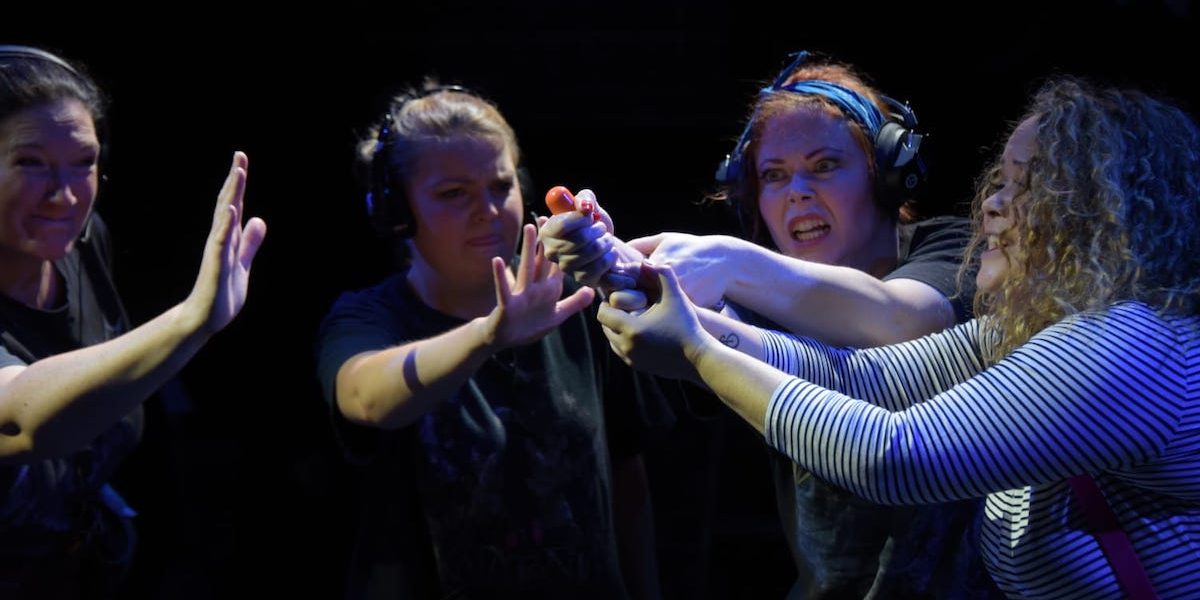This utterly absorbing retelling of The Magic Flute is a triumph for Opera Alegria – and for the Arcola Theatre’s Grimeborn season. I must confess to having seem many Flute productions since my first – in 1960 – and to loving this most accessible of Mozart’s opera masterpieces. I think that the work is strong enough to bear both traditional “freemason” versions and radical versions – e.g. with Sarastro as a fascist dictator! Even so, I have to say that this version will live in my memory. It is quite rightly both funny and profound – it focusses on conflict between different ideas of what music theatre is for, and it is set in the contemporary context of a performance world that has been turned upside down by the pandemic. Not every aspect of the revised story works but the parallel love stories of ‘Prince and Princess’ and ‘Everyman and Everywoman’ (with a twist) still form a joyful framework for the drama as it unfolds.
The action is set in a theatre that has been mothballed. Tamino is an accountant who discovers an ambition to go on the stage. Pamina is the daughter of a fading diva from the old school, the Queen of the Night – but she has joined the acting school of Sarastro a ‘conceptual director’. Tamino’s original intention is to return Pamina to her mother’s influence but somehow he finds himself drawn to Sarastro’s pompous nonsense and becomes a student of his method. In his quest he is assisted by Papageno, a spotlight operator waiting for the theatre to return to life. The three ladies are theatre cleaners – and the same singers are the three boys, in this version the stage management. The work ends with a hint that Tamino and Pamina have found a way to learn from both theatrical traditions and to forge a new performance style, freed from the cant of Sarastro and posturing of the Queen.
All this would mean very little if Mozart’s wonderful music was abandoned in telling the new story but it is not. Musical director (and pianist) Lindsay Bramley does a remarkable job on her keyboards to bring the music to life – not always with 100% accuracy but always with wit and verve. And some of the singing is brilliant and worthy of more celebrated venues. In particular, Naomi Kilby as Pamina is simply superb. She is not the storm-tossed innocent of some versions and, as hinted in Schikaneder’s original libretto, she leads Tamino to enlightenment. But her version of the “Ach, ich fuhls” aria near the end of the opera was one of the best I have ever heard – sweet and beautiful but aching with sadness and disillusion – and, in the intimate but unforgiving space of the big studio at the Arcola, all the more remarkable. Her Tamino, tenor Peter Martin, had less opportunity to show the heroic side of the prince but he sang with poise and charm and his interchanges with Papageno touched the right notes. Fae Evelyn as a ‘Bette Davis’ version of the Queen was effectively sinister though found the stratospheric sections of her big aria challenging. Alistair Sutherland’s Sarastro – Peter Sellers playing Lee Strasberg perhaps – was suitably daft and profound by turns but some of the grandeur of the deep bass lines of the High Priest of the original went awol. But I loved his accordion turn at the beginning of the second half.
There was not a weak link anywhere in the cast of twelve and the final chorus, one of Mozart’s moments of genius, when he transforms a routine happy ending into a brief but glorious celebration of the chance for flawed human beings to find enlightenment and happiness, was wonderful. The audience loved it – and so did I.

